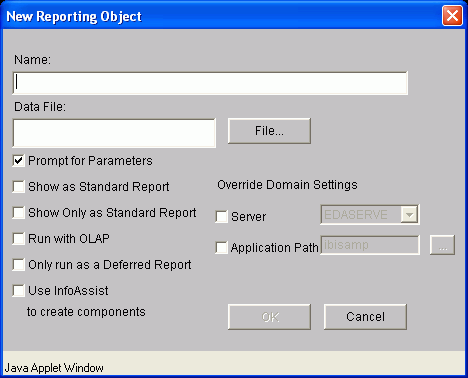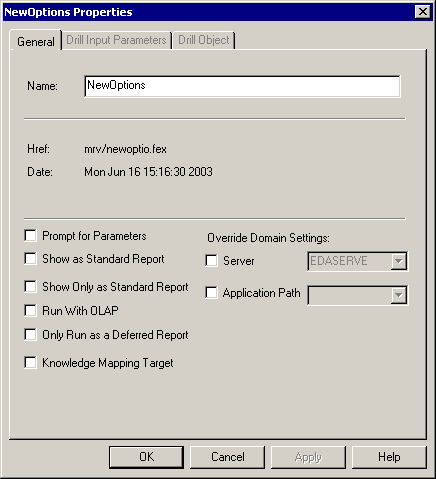WebFOCUS
Online Help > Managed Reporting Developer > Creating Reporting Objects > Reporting Objects
Reporting Objects are stored in the
Reporting Objects folder. The Reporting Objects folder contains simple views of
your data that users access to create their own reports. You begin creating a
Reporting Object by first defining a Reporting Object group folder. You
organize the Reporting Objects under group folders.
After you define a group folder, you
define one or more Reporting Objects in that folder. The Reporting Objects that
you create can include selection criteria (WHEREs), JOINs, virtual fields
(DEFINEs), Filters, and other FOCUS statements, as well as Reports and Graphs,
which you supply as templates. You use these Reporting Object components to
define the Reporting Objects that are available to the Managed Reporting user
environment.
Procedure: How to Create a Reporting Object Group
Folder and Subgroup Folder
-
Expand the domain in
which you want to add a Reporting Object by clicking the plus sign (+) next to
the domain name.
-
Right-click the
Reporting
Objects folder and select
New
Reporting Object Group.
The New Reporting Object Group
dialog box opens.
-
In the Name field, type
the name of the Reporting Object group.
-
Click
OK.
The new Reporting Object group
folder appears below the Reporting Object component folder.
-
To create a new
Reporting Object subgroup folder, right-click the
Reporting
Object group folder and select
New
Reporting Object, then,
New
Folder.
The New Reporting Group subgroup
folder opens.
-
In the Name field, type
the name of the Reporting Object subgroup.
-
Click
OK.
The new Reporting Object subgroup
folder appears below the Reporting Object group folder.
Procedure: How to Define a Reporting Object
After you have defined the Reporting
Object group folder, you can create the actual Reporting Object.
-
In the browser,
right-click a Reporting Object group folder, select
New
Reporting Object, then
New
Reporting Object.
In Developer Studio, right-click a
Reporting Object group folder, select
New
Reporting Object, and then
Reporting Object.
The New Reporting Object dialog
box opens, as shown in the following image.

-
In the Name field, type
a descriptive name for the Reporting Object.
-
Optionally, check
Server and choose a server from
the drop-down list.
-
Optionally, check
Application Path to choose your
application and override the server default search path.
See
Working With the Server
and Application Path Properties in the
Creating Domains
section of the
WebFOCUS Managed Reporting
Administrator's Manual.
Note: You must have the Data Server privilege to
change the Server and Application Path.
-
In the Data File field,
type the name of a data description to be associated with the Reporting Object.
You can also click
File to browse the available
files. Select the data description and click
OK to return to the New
Reporting Object dialog box.
-
WebFOCUS offers the
following optional features when creating your Reporting Object:
- If you check the
Prompt
for Parameters check box, WebFOCUS prompts the user to supply a
value (parameter) when the Reporting Object is used to create a My Report.
- If you check
Show
as Standard Report, WebFOCUS lists the Reporting Object under the
Standard Reports tab in addition to the Reporting Objects tab in the Domains
reporting environment. A user can then run the Reporting Object as if it was a
Standard Report.
- If you check
Show
Only as Standard Report, WebFOCUS will only display the Reporting
Object under the Standard Reports tab in the Domains environment.
Caution: When you create a Reporting Object, do
not click the
Report Painter button on the
Report Assistant window unless you also check
Show
Only as Standard Report on the New Reporting Object window. You
cannot open Reporting Objects created with Report Painter with the Report
Assistant in Managed Reporting. However, you can run a Reporting Object when it
is shown as a Standard Report.
- If you check
Run
with OLAP and you have OLAP-enabled the Reporting Object, users can
run the Reporting Object using OLAP capabilities.
- If you check
Only
run as a Deferred Report, WebFOCUS always submits this report in
deferred mode.
See the
WebFOCUS Managed
Reporting End User's Manual
for more information.
- If you check
Use
InfoAssist to create components, then InfoAssist will be the only
Reporting tool available from the drop-down list to open this Object in
Business Intelligence Dashboard.
-
Click
OK.
The Managed Reporting Domain
Builder in the browser displays the new group folder and Reporting Object.
Note: You may be prompted for WebFOCUS Server
credentials when you click the
File button or
OK button, depending on your
environment.
Procedure: How to Review Reporting Object Properties
-
Expand the domain that
contains the Reporting Object you want to review.
-
Expand the
Reporting
Objects folder and then expand the Reporting Objects group folder
that contains the Reporting Object.
-
Right-click the
Reporting Object you want to review, and select
Properties. The Reporting Object
Properties dialog box opens as shown in the following image.

This dialog box lists the name of
the Reporting Object, the date the Reporting Object was created, the file name
for the Reporting Object, and the HTML launch page that can be used to run the
Reporting Object.
-
To:
- Change the Reporting Object name, type a new name in the
Name input box.
- Select amper auto prompting, check the
Prompt
for Parameters check box.
- Display as a Standard Report, check
Show
as Standard Report.
- Display only as a Standard Report, check
Show
Only as Standard Report.
- OLAP-enable the report, check the
Run
with OLAP check box.
- Only run the report in deferred mode, check the
Only
run as Deferred Report check box.
- Select a server, check the
Server check box, and select a
server from the drop-down list.
- Select an application, check the
Application Path check box.
Select an application from the drop-down list. In the browser, click the
ellipsis button to open a separate window that lists the applications from
which you can select. See
Working With the Server
and Application Path Properties in the
Creating Domains
section of the
WebFOCUS Managed
Reporting Administrator's Manual.
-
Click
OK to save your changes or click
Cancel to discard your changes.
Cutting or Copying and Pasting a
Reporting Object
When you copy or cut and paste a Reporting Object,
Managed Reporting evaluates the request based on the destination location and
whether or not the internal name and/or the display name of the source file
exists in the destination location. When you paste a Reporting Object, one of
the following scenarios occur:
- If you are pasting within the same domain and the same
folder, then the new file is created with a new internal name and a copy number
is appended to the new file tree name, for example, Sales Summary (Copy1).
- If you are pasting within the same domain, but to a
different folder, then the Confirm Create New File dialog box opens notifying
you that the internal name of the file you are copying already exists in the
destination location.
- If you are pasting to a different domain and the internal
name exists in the destination location, then the Confirm File Replace dialog
box opens with the option to either copy the source file and create a new
internal name, or overwrite the existing file with the content, properties, and
name of the source file.

